Opened: The Liberty Theatre opened in 1910. It was on the east side of the street opposite 3rd, which at the
time had a dead end at Main then took a jog to the south to continue east. Thanks to Ken McIntyre for finding the card for a post on the Photos of Los Angeles private Facebook group.
Joe Vogel found an item in the February 10, 1910 issue of the trade magazine The Nickelodeon:
"Los Angeles, CAL. — J. O. Kaiser, Joseph Sturm and E. J. Tally have leased the property at 266-268 South Main street for ten years at a total rental of about $60,000 and will erect a moving picture theater thereon."
Noirish Los Angeles and Cinema Treasures contributor Tovangar 2 dug out
the building permit information. The permit for a "motion picture
theater" dated March 10, 1910 by architect Albert C. Martin was for
owners Kaiser, Sturm and Tally. The address given was 266-268 S. Main.
The dimensions were 30' x 140'.
A L.A. Times item noted that the new
theatre would "have a metal front, pressed steel ceiling, composition
roof, concrete floor, tile floor and marble wainscot in lobby, opera
chairs, etc." The Times also mentioned that the three partners in the project
also ran the Wonderland Theatre (much later called the Jade) at 315 S. Main. Edward J. Tally was Thomas Tally's brother. Evidently Tally dropped out of this partnership prior to the theatre's opening. See the page on the College Theatre for a list of E.J.'s other exhibition adventures.
Seating: 540
Pipe Organ: It was an Estey, according to Chris Rini. The Moving Picture World article below notes that the organ loft was up next to the projection booth.
The construction firm of P. J. Bolin built the structure for proprietors Kaiser, Sturm and Hughes. The latter evidently replacing Tally. The building is described at length in an April 1, 1911 Moving Picture World article:
"The floor of the lobby is of white tile, inlaid with a series of swastika design borders in green tile. The side walls of the lobby are wainscoted in white Italian marble to a height of eight feet, crowning which is a twelve-inch molded cap of mahogany. The entrance doors are of mahogany, their bases trimmed in brass, and their upper panels of plate glass. The box office is roomy. It is also wainscoted in marble, the woodwork of the upper part being in mahogany and the windows of plate glass. The brick wall of the lobby contains a beautiful leaded art glass window, semi-circular in shape, with a landscape design of beautiful coloring, especially so when seen illuminated at night. Bordering the design are the words 'Continuous Performance.' Radiating from the art glass window, which forms the nucleus of the shell, are a series of stucco shell ribs, each containing fifteen clear-globed eight-candlepower lights.
"The inner lobby leading to the auditorium is 15x20 feet in size. The floor is of white tile, with six inch baseboard of marble. The lobby is paneled in oak to a height of 30 inches, above which it is covered with an imitation leather fabric. Opening off the lobby are retiring rooms for both men and women, the rooms also being finished in tile and marble. A narrow stairway opening off the lobby leads to the office, operators booth and organ loft. The operators booth is roomy and is equipped with the latest apparatus, including two Edengraph projectoscopes and a stereopticon. To the right of the operator's balcony is the organ loft, containing a large pipe organ, a valuable addition to the orchestra in accompanying religious and special films.
"The [auditorium] seats are of wood with iron standards. The side walls of the auditorium are paneled to a height of three feet in oak, above which are a series of five landscape paintings on each side, the borders of which are outlined with stenciled designs of a darker shade than the light green color scheme of the side walls. The height of the auditorium is twenty-four feet, and the stage is sixteen feet square. Facing the stage on each side are singing booths.
"The auditorium is illuminated by ceiling lights and ten pairs of art glass side lights of tulip design with green globes. The ceiling is of white plaster with cream trim, and from it are suspended five electric fans. The theatre is showing four first-run licensed films, and one illustrated song, except on Saturdays and Sundays, when two songs are used. The theater employs ten people. Girl ushers look after the seating arrangements. Five cents admission is charged to all parts of the house. The theatre was completed early in the year and has played to good business ever since."
Thanks to Brooklyn-based theatre historian Cezar Del Valle for finding the article for a 2012 Theatre Talks blog post about the theatre. To stay current with Cezar's explorations see the Theatre Talks website and visit him on Facebook.
The 1911 city directory lists it under "moving picture theaters" both as Kaiser, Sturm & Hughes and as the Liberty. In the 1913 directory it gets a listing as Sturm, Hughes & Rittigstein.
The Liberty is seen opposite 3rd St. in this detail from Plate 002 of the 1914 Baist Real Estate Survey from Historic Map Works. The portion of 3rd on the east side of Main St. was originally called Mayo.
It's in the 1915 city directory as the Liberty (but not the 1914 edition). It was still in the 1929 city directory but that was the end of it.
Closed: 1929. Part of the property was lost when 3rd St. was pushed through to eliminate a jog at Main St.
A sale of the contents of the building was announced in the August 26, 1929 issue of the Times. Thanks to Noirish Los Angeles contributor Lorendoc for finding the Times items for Noirish post #48352.
More exterior views:
c.1910 - Looking south toward 3rd St. before the Liberty arrived. That's Glockner's Automatic Theatre (earlier Tally's Electric) on the left. The sliver of a building just beyond with the billboard above the storefront would soon be demolished for the Liberty Theatre. Beyond that, we see the Gray Hotel building on the NE corner of 3rd & Main. The California Historical Society photo appears on the USC Digital Library website.
1911 - Another version of the Liberty postcard with different coloring. This one is from the Theatre Talks collection of Cezar Del Valle. This copy was mailed in 1918 with the message scrawled on the back saying "Just one of our many 5 cent theatres."
1911 - Thanks to Ken McIntyre for this version of the photo that the postcards were based on, a post on the private Facebook group Photos of Los Angeles.
1911 - The retouched version of the photo that appeared with the 1911 Moving Picture World article.
c.1912 - A view east by G. Haven Bishop. The photo, taken for the Southern California Edison Co., is in the Huntington Library collection. They date this one as 1912. They have another slightly wider version of the same photo which has the date 1-7-11 written on it.
1912 - A closer look at the theatre at night. It's a G. Haven Bishop photo for Southern California Edison that's in the Huntington Library collection.
1912 - A detail of the theatre's clamshell entrance from the previous photo.
c.1915 - Looking east on 3rd toward the Liberty from Angels Flight. It's a California Historical Society photo appearing on the USC Digital Library website. It was obviously taken before mid-1917 as construction hasn't begun on the Million Dollar at 3rd and Broadway.
c.1915 - A detail from the previous photo. You took a jog to the right to continue east on 3rd.
c.1918 - Thanks to Brent Dickerson for sharing this view east.
1922 - The view east toward the Liberty's arched entrance from the top of the 3rd St. tunnel. It's a photo from the Automobile Club of Southern California that appears on the USC Digital Library website.
1929 - A terrific look at the theatre in a September 24, 1929 photo from the City of Los Angeles Engineering Department on the Los Angeles City Historical Society website. They're running "The Primrose Path," a 1925 Clara Bow feature. Also on the bill is "Adventures in the Far North," a 1923 travel film. Thanks to Noirish Los Angeles contributor Fred H, who included the photo in his Noirish post #23527. And thanks also to ace theatre photographer Hunter Kerhart for spotting the post.
Tally's Electric was once in the Harris Hardware building seen at the left. The Liberty and the Gray Hotel on the right were both doomed at the time of the photo. The hotel and most of the Liberty's building were soon demolished to extend 3rd St. to eliminate a jog.
1960 - A view of the 3rd & Main intersection looking west by Palmer Connor. That diagonally sheared-off building on the right is the remnant of the Liberty. The photo was taking note of the building straight ahead that soon would be getting its upper stories getting lopped off to become a one story building. It was designed by A.M. Edelman, architect of the Empress/Capitol and Follies theatres. The slide is in the collection of the Huntington Library.
1980s - Thanks to Noirish Los Angeles contributor Scott Charles for this photo he took of the remnant of the Liberty building. It's included with some other building shots on his Noirish post #48289.
1991 - A photo by Cary Moore that's in the Los Angeles Public Library collection.
2010 - The remains of the Liberty building. Photo: Bill Counter
The Liberty Theatre in the Movies:
We spend a lot
of time in the cafes, donut shops and bars of Main St. in Kent MacKenzie's "The Exiles." The film, about 24 hours in the life of a
group of Native Americans in downtown Los Angeles, was shot in 1958-59
and released in 1961. In this shot looking north toward 3rd the triangular Enderle Hardware building on
the right is what remains of the Liberty. The
building just beyond once housed Tally's Electric Theatre at 262 S.
Main. See the Historic L.A. Theatres in Movies post for shots of the Roxie, Cameo, Arcade and Los Angeles from the film.
Jeff Bridges has a nice aerial view and vintage insurance map of 3rd and Main on Flickr. The building that remains from the Liberty is featured in an interesting Noirish Los Angeles post #3286 by Gaylord Wilshire. The post also has several nice views of the recent garage construction just north of the building.
Just north of the Liberty was Tally's Electric Theatre (later called the Lyric and Glockner's Automatic) a house that opened in 1902 and is considered to be the first L.A. venue exclusively for movies.
The other Liberty Theatre: In the 40s the theatre at 136 S. Main St. used the Liberty name. See the page for that one under its earlier name Novelty Theatre.
| back to top | Downtown: theatre district overview | Hill St. and farther west | Broadway theatres | Spring St. theatres | Main St. and farther east | downtown theatres by address | downtown theatres alphabetical list |
| Westside | Hollywood | Westwood and Brentwood | Along the Coast | [more] Los Angeles movie palaces | the main alphabetical list | theatre history resources | film and theatre tech resources | theatres in movies | LA Theatres on facebook | contact info | welcome and site navigation guide |
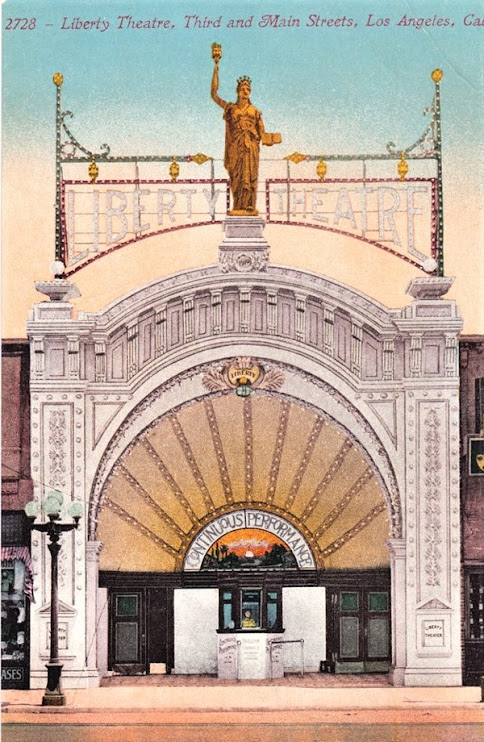





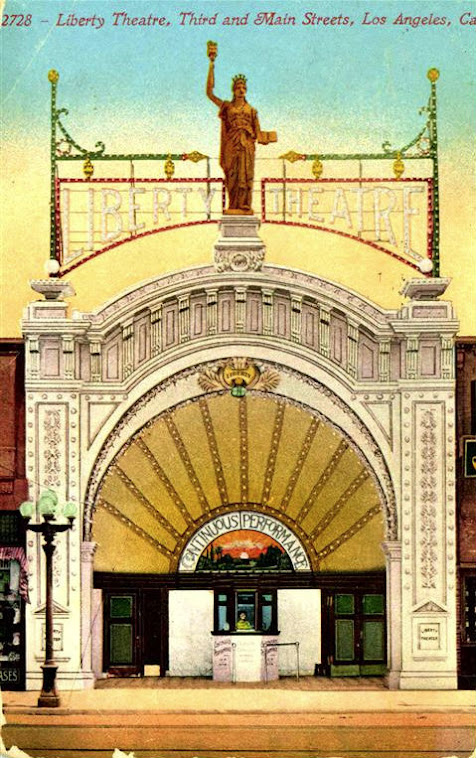

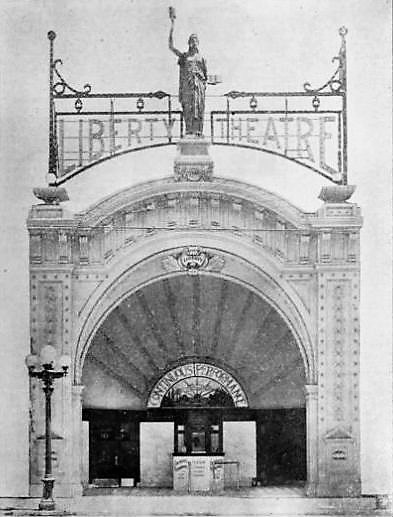












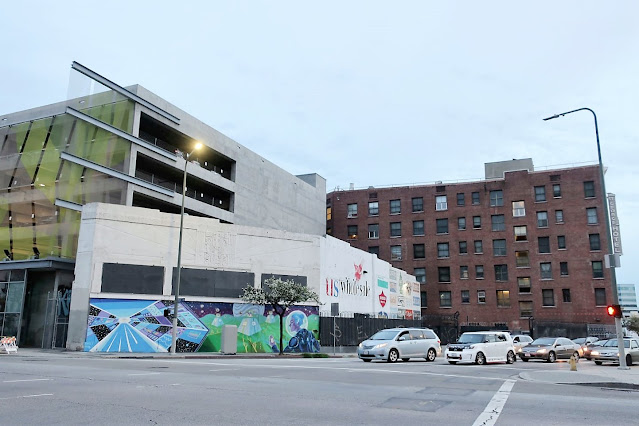

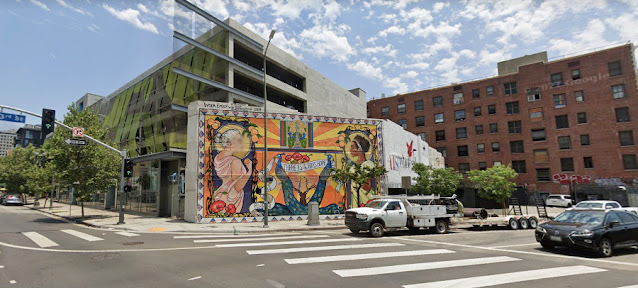




Great save on Los Angeles history!
ReplyDelete